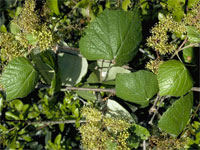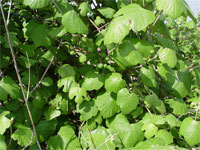Wild About Texas – April, 2008

Mustang grapes (Vitis mustangensis) can be harvested and cured as grape “olives” when they are the size of marbles or merely the size of peas.
Top photo by Melody Lytle. Bottom photo by Mrs. W.D. Bransford.
Grape Olives:
Stalking the Wild Grape
It’s a little early to start thinking about grapes as we usually do – dark and ripe (typically in summer) – but grapevines will be blooming soon, followed by tiny immature fruits. These pea- to marble-sized grapes are what we are interested in when we want to make grape “olives.” I am writing about them now so that you will be able to pay closer attention to that window of development when they are just right for harvest. (Read on for a recipe.)
My experience with native grapes is mostly with mustang grapes (Vitis mustangensis), which are found in the eastern half of Texas. I assume other grape species will also work, but I have not tried them. The leaves of mustangs vary quite a bit, making them confusing to identify. Some look almost heart-shaped; others are deeply lobed. Turn the leaf over; if it is so densely felted that you cannot see the leaf surface, you have a mustang vine. Pop a leaf into your mouth to experience a mildly sour and tasty “gum.” You can seemingly chew forever; it won’t go away.
When given enough moisture (average rainfall is enough in most of the state), mustang grapes grow quite well in full sun or considerable shade, and in just about any soil type. The trick is finding a source if you don’t already have the vines growing on your property. Mustang grapes are not easily found in nurseries.
Male and female plants can be differentiated only when they’ve bloomed, and that may take a couple of years from seed. (Only female vines will develop fruit.) Mustangs are easy to grow from seed, so you may want to start a few in pots, then set out female and male plants in appropriate locations once you’ve identified which is which. Note: ripe fruits are messy and will stick to shoes and splatter cars and patios, so deliberate carefully on placement.
Wildflower Center land steward Phillip Schulze shares his family recipe for pickled grapes or grape “olives.” Serve them with appetizers, on salads, or in pasta sauces. Enjoy!
GRAPE OLIVES
• Pick grapes when green, before seeds harden (pea to marble size).
• De-stem, clean, and pack into sterile canning jars.
• Prepare brine by boiling 1 cup salt in 2 quarts water.
• Cover grapes with hot brine.
• Add 1 tsp. 5-percent vinegar per pint of grapes.
• Seal jars and store in a dark cabinet for four to six weeks before serving.
Another opportunity to relish green grapes is in the form of green grape pie. Many recipes are available on the Internet. Simply search for “green grape pie.”
For more information about Texas native plants, visit the Wildflower Center’s website at www.wildflower.org.
About the author: Andrea DeLong-Amaya is the director of horticulture at the Lady Bird Johnson Wildflower Center in Austin.


